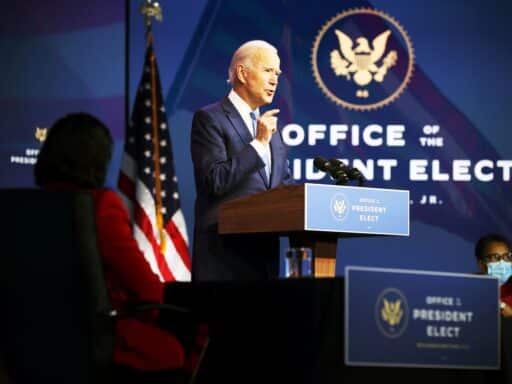Miguel Cardona, Connecticut’s first Latino commissioner of public education, led the state’s schools in responding to Covid-19.
President-elect Joe Biden is expected to pick Miguel Cardona, Connecticut’s commissioner of public education, to be his Department of Education secretary, according to multiple sources. With his nomination, Biden will fulfill his promise to select a public school educator to head the department and further his goal of creating the most diverse cabinet in American history.
Cardona began his career in Meriden, Connecticut, as an elementary school teacher who rose quickly to become a school principal and eventually the state’s first Latino commissioner of education. The Congressional Hispanic Caucus has urged Biden to nominate Cardona, writing that his “record of accomplishments demonstrates that he is capable and qualified to lead,” as well as noting that as “a Puerto Rican leader, he will bring a valued and diverse voice to the Cabinet.”
President-elect Joe Biden has chosen Miguel Cardona, the education commissioner for Connecticut and a former public school teacher, to serve as education secretary, three people familiar with his decision told @AP. https://t.co/x1ME46gFO4
— AP Politics (@AP_Politics) December 22, 2020
If confirmed by the Senate, Cardona won’t be the first Latino Secretary of Education. That distinction belongs to Lauro Cavasos, who served under Presidents Ronald Reagan and George H.W. Bush and was the only secretary of education to serve under two presidents. But Cardona’s background makes him a departure from recent education department heads. According to an interview with the Connecticut Mirror, Cardona was born in a Connecticut housing project, speaking only Spanish when he first attended school, giving him the perspective of the 5 million students across the US who are identified as “English language learners.” Cardona also attended two public universities: Central Connecticut State University for his bachelor’s degree in education and the University of Connecticut for his master’s in bilingual/bicultural education and a doctorate in education.
By contrast, current Education Secretary Betsy DeVos was born into a family of billionaires and attended multiple private schools; Arne Duncan and John King Jr., who served under President Barack Obama, both attended Ivy League universities.
“The passion I have for public education stems from my belief that it is the best lever for economic success and prosperity in Connecticut,” Cardona said in February at his state nomination hearing. “And the belief that public education is still the great equalizer. It was for me.”
Biden’s plan for education, briefly explained
The federal government’s purview over K-12 education is limited. But as Libby Nelson reported for Vox last year, a central component of Biden’s plan, alongside raising teacher pay, is a pledge to triple the funding sent to low-income schools and districts to nearly $50 billion:
Research has found that more spending does make a difference, particularly for low-income students. A 2015 paper looked at the long-term effect of court decisions that forced states to spend more on low-income districts and found that a 10 percent spending increase each year from kindergarten through 12th grade led students to complete a few more months of school, to earn 7.25 percent more, and to be less likely to be poor.
But while this was the framework Biden originally laid out during his campaign, 2020 has brought an onslaught of new problems for schools. With little federal guidance, school systems across the country have been left to figure things out on their own in the pandemic, with state and local officials making calls about whether to send kids back into school buildings, go all-remote, or do a hybrid of both this fall. Meanwhile, children of color, children living in poverty, and students with disabilities have faced the largest disadvantages. A study released by McKinsey & Co earlier this month found that white students were set back in math by one to three months, while students of color were set back between three and five months on average. Meanwhile, 75 percent of teachers point to students’ lack of technological tools and high-speed internet as a large obstacle to remote schooling.
Biden’s concern now is getting students back in the classroom quickly; while there remains some debate, schools don’t appear to be major sources of viral spread in this pandemic, writes Vox’s Anna North. Biden recently pledged to reopen schools by the end of his first 100 days, which would give him until April 30, when most public schools are getting ready to finish out the school year.
Today, I’m announcing key COVID-19 priorities for the first 100 days of my administration:
– Everyone wears a mask
– 100 million vaccinations
– Reopen the majority of schoolsWith these steps, we can change the course of the disease and change life in America for the better.
— Joe Biden (@JoeBiden) December 8, 2020
Cardona was appointed to Connecticut’s Department of Education in August of 2019, so the bulk of his tenure has been focused on helping lead schools in the Covid-19 pandemic.
Cardona has highlighted that “in-person instructional time” is the best way to address “the educational setbacks and the social-emotional toll caused by Covid-19.” However, the Connecticut Mirror reports that only around one-third of the state’s public school students are able to attend school in person full-time. The Mirror writes that Cardona has pushed for schools to reopen while “walk[ing] a political tightrope” to avoid clashes with teachers unions that have largely pushed for the state’s schools to remain closed.
On December 17, Cardona wrote an opinion piece addressed to Connecticut’s educators about the difficulties schools have faced in navigating the pandemic. “As a father of two children attending in-person school in the same district in which close family members work daily,” he wrote, “I want to make clear that I would not ask you, your colleagues, and your family members to place yourselves in a situation in which I myself would not want my loved ones working and learning.”
Author: Jerusalem Demsas
Read More



